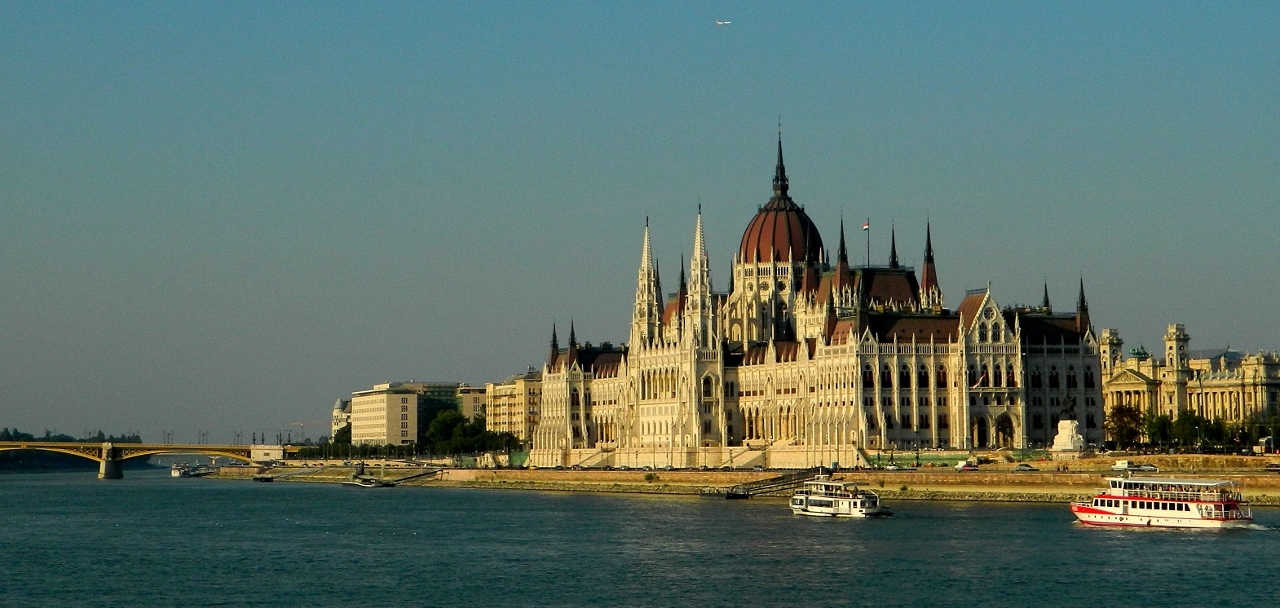Daytime temperatures were in the high 30’s and construction and renovation work created clouds of choking dust but it couldn’t diminish the dazzling beauty of the city, which we saw with new eyes.
Happy enough to wander about the differing districts of neo-classical, baroque and Art Noveau architecture with an ice cream in hand we learned the stories of its tumultuous past, and enjoyed five days of diverse experiences.

Walking the length of Andrassy Avenue it was a delight to see the grand old buildings coming back to life as public and private investment cleans them of their centuries-old grime. Few now had the bizarre overhead netting arrangements we remembered being in place to prevent decaying plaster and building blocks falling on the heads of passers-by.
At the top of the avenue the spectacular Heroes Square of 1896 marks the 10000th anniversary of the Magyar’s conquest of Carpathia. The almost storybook figures of the ferocious-looking and hooded heroes on horseback are a reminder of the romance of Hungarian folk culture.
Before the Magyars came the Romans and Aquincum, in the north of the city, is Hungary’s largest most complete Roman town. We explored the streets around what would have been luxurious houses, temples and public baths, admiring intact heating and drainage systems, floor mosaics and standing columns.
The Lapidary holds carved limestone monuments and you can gaze clearly into the faces of patricians and their families as they wished to be remembered on the covers of their sarcophagi, some holding objects of worship, others of trade. A touchingly beautiful girl gazed back, and a proud horseman held onto the harness of his stallion.
The civilian town runs south into the military one and we walked around the impressive amphitheatre built in the second century for the Roman garrisons and which would have seated 6,000. Not far from here a reminder of another conquering empire, the Ottomans, is worshipped by Muslims in the form of a shrine to Gul Baba.
The dervish was present at the capture of Buda in 1541. Climbing up the steep steps to his shrine we saw it was unfortunately cordoned off as a building site. We chatted with two young Malaysians who were disappointed not to be able to enter the tomb, and with a Turkish family who like us had arrived hot and puffing from the hillside steps.
The Ottomans didn’t build much in what they called Budan, other than their now legendary bath houses. We spent a few hours at Kiraly, an authentically dank and smelly bathhouse built in 1570. Its central circular bath sits under a sky-lit dome and the steaming surrounding baths and saunas are recessed deeply within stone arches. It oozed atmosphere, and sulphur, and although is in desperate need of renovation was an enjoyable way to unwind and escape the dusty heat outside for a while.
Away from the sparkling domes of the religious and royal buildings and the glittering gold-plate of its many Art Noveau facades, Budapest does of course have a very dark 20th century history. This is beautifully and thoughtfully captured at the House of Terror, the former headquarters of the secret police of both the fascist and communist regimes.
We learned a great deal about the atrocities committed first by the Nazi-supporting ‘Arrow Cross’ government and then the Soviet-supported Hungarian Communist Party. Filmed testimony from survivors portrayed the paranoia of living in times of terror and torture. As one elderly man explained of his torture and imprisonment at 21 years’ old for distributing anti-communist leaflets: “It may all seem very childish now. It was futile to resist a fully machinated organisation of terror. But it was politically and symbolically important to resist, and so we did.”
A touching memorial to those of Budapest’s Jewish community, and who were not sent to the Nazi’s labour camps in the first wave of deportation, is ‘Shoes along the Danube’. Bronze sculptured shoes, modelled on 1940’s footwear, line the river’s bank marking where men and women were shot or simply pushed into the freezing waters below. Candles and faded roses are placed amongst them recalling names of family members lost to the horror. It is very moving.

Outside of the city Momento Park is the last resting place of the gigantic communist statues that adorned public spaces in the city for nearly forty years.
Flag waving and muscled youths stride purposely forward amongst friezes of the ‘glorious Soviet Army’ and dismembered body parts of the ideology’s heroes. Stalin’s monstrous boots are a top attraction.
Being on a budget we ate cheaply and deliciously on market-sourced treats. Jostling with locals and tourists alike we feasted on stuffed aubergines, spicy beans, salads and langos, a fried bread served with sweet or savoury toppings.
Coffee is taken short and strong with sugar, not to our liking so we didn’t have many, but stopped again at cafe Bambi a former haunt of secret police and informers and still maintaining its evocative 1960’s interior decor.
Our five days in Budapest exorcised the ghosts of our previous visit and we feel very differently now about this splendid and vibrant city.
As with Vienna, the time we had was simply not enough to fully experience the different cultural life on offer or visit and appreciate all of its artistic and historic heritage. A third visit is a must!
























